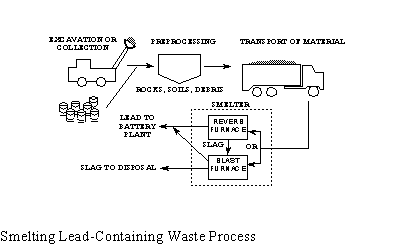
(Smelting Lead-Containing Waste)
TECHNOLOGY DESCRIPTION:
Secondary lead smelting is a proven technology that reclaims lead from lead-acid battery waste sites. The Center for Hazardous Materials Research (CHMR) and Exide Corporation (Exide) have demonstrated the use of secondary lead smelting to reclaim usable lead from various types of waste materials from Superfund and other lead-containing sites. Reclamation of lead is based on existing lead smelting procedures and basic pyrometallurgy.
The figure below is a generalized process flow diagram. Waste material is first excavated from Superfund sites or collected from other sources. The waste is then preprocessed to reduce particle size and to remove rocks, soil, and other debris. Next, the waste is transported to the smelter.

At the smelter, waste is fed to reverberatory or blast furnaces, depending on particle size or lead content. The two reverberatory furnaces normally treat lead from waste lead-acid batteries, as well as other lead-containing material. The furnaces are periodically tapped to remove slag, which contains 60 to 70 percent lead, and a soft pure lead product.
The two blast furnaces treat slag generated from the reverberatory furnaces, as well as larger- sized lead-containing waste. These furnaces are tapped continuously for lead and tapped intermittently to remove slag, which is transported offsite for disposal. The reverberatory and blast furnace combination at Exide can reclaim lead from batteries and waste with greater than 99 percent efficiency.
The process has been demonstrated to reclaim lead from a variety of solid materials, including rubber battery case material, lead dross, iron shot abrasive blasting material, and wood from demolition of houses coated with lead paint. The technology is applicable to solid wastes containing more than 2 percent lead, provided that they do not contain excessive amounts of calcium, silica, aluminum, or other similar constituents. Explosive and flammable liquids cannot be processed in the furnace. As tested, this technology is not applicable to soil remediation.
This technology was accepted into the SITE Emerging Technology Program in July 1991. Field work for the project was completed in February 1993.
The process was tested at three Superfund sites. Materials obtained from two additional sites were also used for these tests. Results from the Emerging Technology Program, presented in the table below, show that the process is applicable to waste materials at each site and economically feasible for all but demolition material. The Emerging Technology Bulletin (EPA/540/F-94/510), the Emerging Technology Summary (EPA/540/SR-95/504), and the Emerging Technology Report (EPA/540/R-95/504) are available from EPA. An article about the technology was also published by the Journal of Hazardous Materials in February 1995.
Specific technical problems encountered included (1) loss of furnace production due to material buildup within the furnaces, (2) breakdowns in the feed system due to mechanical overloads, and (3) increased oxygen demands inside the furnaces. All of these problems were solved by adjusting material feed rates or furnace parameters. Based on these tests, CHMR has concluded that secondary lead smelting is an economical method of reclaiming lead from lead-containing waste material collected at Superfund sites and other sources.

EPA PROJECT MANAGER:
Laurel Staley
U.S. EPA
National Risk Management Research Laboratory
26 West Martin Luther King Drive
Cincinnati, OH 45268
513-569-7863
Fax: 513-569-7105
TECHNOLOGY DEVELOPER CONTACT:
Stephen Paff
Center for Hazardous Materials Research
320 William Pitt Way
Pittsburgh, PA 15238
412-826-5321, ext. 233
Fax: 412-826-5552